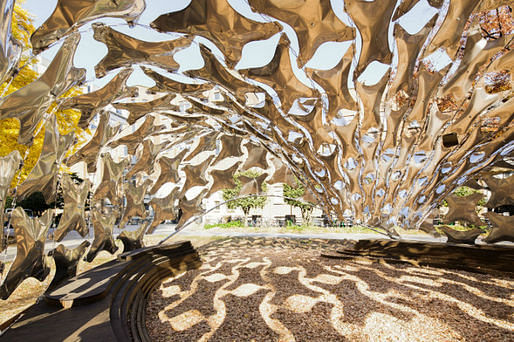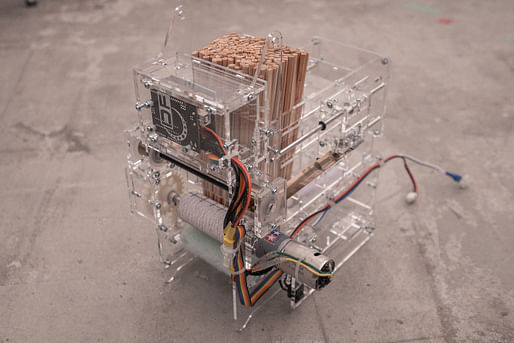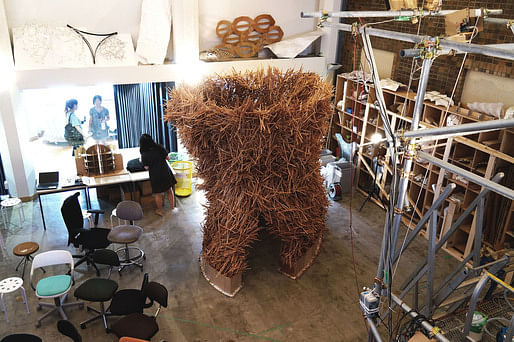
I've been receiving some questions recently regarding the Master's program here at the University of Tokyo, and thought I'd briefly share how the course is structured and what we were up to the past year.
The system here at the University of Tokyo is divided in "labs" and is probably closer in spirit to the AA than to US schools, where you spend a year or even the entire course of your program under the tutelage of one professor. In order to graduate, you have to do a research project that goes beyond a design proposal.
Obuchi lab specifically focuses on fabrication, with an attempt to make full-scale mock-ups and pavilions that investigate some kind of new material, fabrication, or structural system.
The first few months of the program are spent fabricating the pavilions and concepts developed from the preceding year's research. When I came, I worked on a project that involved casting a series of differentiated bricks and stacking them to form curved surfaces for several weeks, and then spent a little more than a month working on the 99 Failures Pavilion, a large tensegrity project made of inflated metal panels.


By working through the process and utilizing the Rhino, Grasshopper, and Python scripts made prior, one learns both the digital tools as well as the outputs required to build these structures.
After the initial two months, there's a five month period were one works both individually and in teams to come up with proposals for next years' pavilion. Having worked on the brick project previously, I was interested in continuing to explore casting methods with several other research-mates.



In May, the lab, in conversation with Sato Lab, a structural engineering lab, Igarashi Lab, a computer science lab, and Shimizu Corporation, one of Japan's large zenekons, decided to proceed with a proposal that involved the aggregation of wari-bashi (chopsticks) to form structures. At this point, myself and the other seven students re-mobilized to form several teams looking at different issues regarding the development of the system.

We developed the project through the construction of physical mock-ups and crush-tests, and utilized Karamba, Processing, and Hogan to test potential aggregation patterns and structures.



In addition, we required a consistent, efficient way to drop the sticks. This idea became known around the lab as the "smart tool" concept.
The concept is that rather than trying to automate the entire construction process, it's possible to allow computers to augment the intuition and logic of humans. For this project, we built a mechanism that is able to drop the sticks and automatically dispense glue, allowing the fabricator to concentrate on letting the material aggregate where it's needed.



Besides the automation of the dispensing process, we also made a tracking and angle dropping system. We connected the tool to a series of pulleys, which allowed us to track the precise location of the tool in space, this data was sent back to processing and the information was forwarded to an iPhone application, which gave instructions to the fabricator as to what angle to drop the sticks in order to create the desired geometry. We used this system to build a large-scale mock-up in August, prior to constructing the final pavilion in November.


In addition to the location tracking system, we developed a projection mapping system utilizing Kinect 2, the scanning system used with Xbox. In conjunction with Igarashi Lab, a program was built that scans objects in real-time and then projects a colour-coded map of where more material (sticks) need to be aggregated to reach a target geometry. More information on the fabrication process and research can be found here and here.


After we completed the mock-up we had a break in September, where some of us went to work at local architecture firms here in Tokyo or decided to travel around Japan or visit home.
This process basically repeated itself for last years new class of students, where they helped us finalize the design and fabrication of the pavilion. We built the final pavilion, as well as a food stall in Omotesando, in November.



As the final pavilion is being constructed, 2nd year students begin developing their master's thesis. I'll try to add some posts about our 2nd year thesis projects in the next few days.
A student blog dedicated to ongoing happenings in and outside the Advanced Design Studies Program at the University of Tokyo.


No Comments
Block this user
Are you sure you want to block this user and hide all related comments throughout the site?
Archinect
This is your first comment on Archinect. Your comment will be visible once approved.